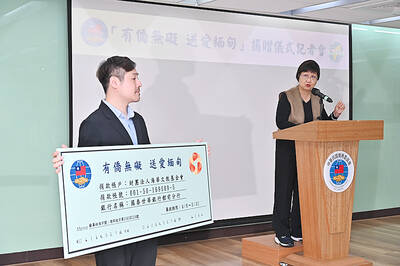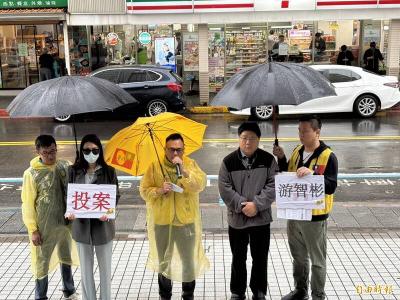The Sino-Japanese Treaty is a treaty verified by international law that clearly states that Taiwan was returned to the Republic of China (ROC), President Ma Ying-jeou (馬英九) said yesterday.
Ma made the remarks at an exhibition held by the Academia Historica and the Ministry of Foreign Affairs marking the 60th anniversary of the signing of the Sino-Japanese Treaty, also known as the Treaty of Taipei.
Ma said that according to the Cairo Declaration jointly issued by the ROC, the US and Britain on Dec. 1, 1943, Article 8 of the Potsdam Declaration, issued on July 26, 1945, and the Japanese Instrument of Surrender, all three stated clearly that after World War II, Japan agreed to return what was then known as Manchuria, including current-day Liaoning, Jilin and Heilongjiang provinces, Taiwan (Formosa), and Penghu (the Pescadores) to the ROC.
These three documents were made within the powers given to the leaders of state during wartime, so all promises listed therein are of course legally binding, he said.
The Treaty of Taipei was signed on April 28, 1952, in Taipei by the Republic of China (ROC) government and the government of Japan and went into effect on Aug. 5 the same year, ending the state of war between the two nations.
Ma said the treaty stated the “renouncement to all right, title and claim to Taiwan (Formosa) and Penghu (the Pescadores) as well as the Spratly Islands [Nansha Islands, 南沙群島] and the Paracel Islands [Xisha Islands, 西沙群島]” by the Japanese and that “all treaties, conventions and agreements concluded before Dec. 9, 1941, between Japan and China have become null and void as a consequence of the war.”
The statement that “nationals of the Republic of China shall be deemed to include all the inhabitants and former inhabitants of Taiwan (Formosa) and Penghu (the Pescadores) and their descendants who are of the Chinese nationality” also clearly represented the fact that Taiwan had been returned to the ROC, Ma said.
Mentioning the First Note of the treaty, which stated: “In -regard to the Treaty of Peace between Japan and the Republic of China signed this day ... the understanding reached ... shall, in respect of the Republic of China, be applicable to all the territories which are now, or which may hereafter be, under the control of its Government,” Ma said the treaty pertained to all territories that were and will be owned by the ROC, which, he added, includes Taiwan.
Separately yesterday, former representative to Japan Lo Fu-chen (羅福全) said Ma distorted the interpretation of the Sino-Japanese Treaty.
While Japan renounced territorial claims to Taiwan, Penghu, the Spratlys and the Paracels in the Treaty of San Francisco, Taiwan’s status after World War II remains undetermined as it did not state which country Taiwan belonged to, Lo said.
Noting Ma had said during his 2008 presidential campaign that “Taiwan’s future should be determined by the 23 million Taiwanese,” Lo said it suggested the president supported Taiwan’s undetermined status theory.
Additional reporting by Chris Wang

Taiwan is stepping up plans to create self-sufficient supply chains for combat drones and increase foreign orders from the US to counter China’s numerical superiority, a defense official said on Saturday. Commenting on condition of anonymity, the official said the nation’s armed forces are in agreement with US Admiral Samuel Paparo’s assessment that Taiwan’s military must be prepared to turn the nation’s waters into a “hellscape” for the Chinese People’s Liberation Army (PLA). Paparo, the commander of the US Indo-Pacific Command, reiterated the concept during a Congressional hearing in Washington on Wednesday. He first coined the term in a security conference last

A magnitude 4.3 earthquake struck eastern Taiwan's Hualien County at 8:31am today, according to the Central Weather Administration (CWA). The epicenter of the temblor was located in Hualien County, about 70.3 kilometers south southwest of Hualien County Hall, at a depth of 23.2km, according to the administration. There were no immediate reports of damage resulting from the quake. The earthquake's intensity, which gauges the actual effect of a temblor, was highest in Taitung County, where it measured 3 on Taiwan's 7-tier intensity scale. The quake also measured an intensity of 2 in Hualien and Nantou counties, the CWA said.

The Overseas Community Affairs Council (OCAC) yesterday announced a fundraising campaign to support survivors of the magnitude 7.7 earthquake that struck Myanmar on March 28, with two prayer events scheduled in Taipei and Taichung later this week. “While initial rescue operations have concluded [in Myanmar], many survivors are now facing increasingly difficult living conditions,” OCAC Minister Hsu Chia-ching (徐佳青) told a news conference in Taipei. The fundraising campaign, which runs through May 31, is focused on supporting the reconstruction of damaged overseas compatriot schools, assisting students from Myanmar in Taiwan, and providing essential items, such as drinking water, food and medical supplies,

New Party Deputy Secretary-General You Chih-pin (游智彬) this morning went to the National Immigration Agency (NIA) to “turn himself in” after being notified that he had failed to provide proof of having renounced his Chinese household registration. He was one of more than 10,000 naturalized Taiwanese citizens from China who were informed by the NIA that their Taiwanese citizenship might be revoked if they fail to provide the proof in three months, people familiar with the matter said. You said he has proof that he had renounced his Chinese household registration and demanded the NIA provide proof that he still had Chinese